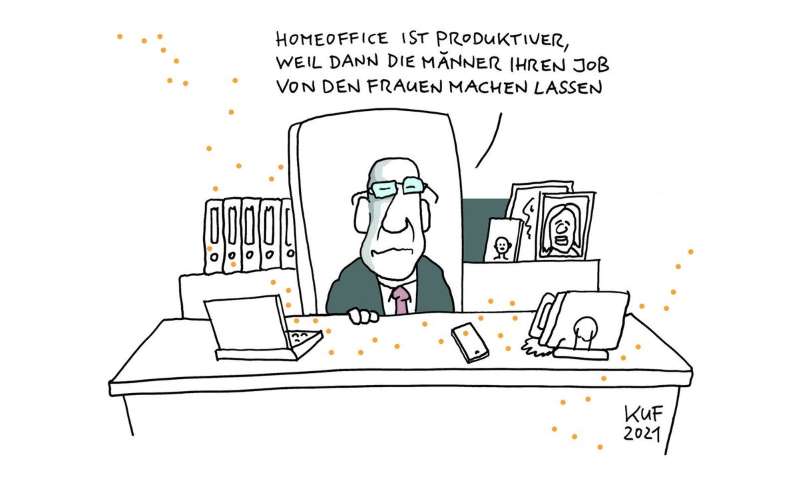
In the corona pandemic, the home office, i.e. teleworking, was used on a large scale for the first time. In view of the closed schools and kindergartens, although many could not really work efficiently from home, we can still assume that the home office will remain in the long term. Because under “normal” circumstances, companies could significantly reduce their costs without sacrificing productivity.
Some also see the widespread use of telework as the solution to the gender pay gap, which describes the income differences between women and men that have always existed on the labor market. But is there anything to it?
Austria is one of the European countries with the greatest income differences between men and women. This has primarily to do with the fact that women in Germany are more likely than elsewhere to leave work when they have children. However, in those countries in which a large number of mothers are no longer active in the labor market, the gender pay gaps are also smaller, because these women are not even statistically recorded. In Austria, on the other hand, participation rates in the labor market are high. But mothers in particular mainly work part-time, which in turn makes the gender pay gap statistically higher.
Self-determined choice?
It is now undisputed that the gender pay gap mainly affects mothers and primarily traces their income losses, which arise from their additional tasks in the context of family work. The reasons for this, however, are less clear: Is it really the result of self-determined decisions within the families? Does the status quo match mothers' preferences? How big is the influence of social norms and ideas about the “correct” division of family work? And what is the proportion of unfavorable institutional framework conditions, such as employers' expectations regarding the flexibility of parents – for example meetings called late, coupled with an inadequate childcare infrastructure?
What does the empirical evidence say? In a study published in 2020, Kleven, Landais and Søgaard showed that purely biological factors (maternity leave, childbirth, puerperium, etc.) play a subordinate role in the question of the gender pay gap: the income losses are similar to those of adoptive parents natural parents.
Other studies show that mothers' income losses are significantly lower in homosexual parents than in heterosexual couples. The division of housework is also more evenly distributed among homosexual couples. Where traditional notions of the family are more prevalent, the postpartum loss of income for mothers is higher. In addition, studies show that the partner who has less chance of high income in the future (often the wife) is also the one who will care more for the children after the birth.
Working from home may help us to change unfavorable framework conditions. Economists who consider teleworking to be the method of choice in the fight against the gender pay gap emphasize that this is primarily due to the work structures and the inadequate supply of childcare options. The line of argument goes back to the Harvard economist Claudia Goldin, who considers the lack of flexible work arrangements, especially in well-paid jobs (e.g. in financial services), to be one of the main causes of the gender pay gap.
Multitasking in the home office
However, other results are skeptical: a study by the University of Oxford evaluated the income of people who are employed by the Amazon Mechanical Turk (MTurk) crowdworking platform. All participants work from home; there is no opportunity to discriminate according to gender in the distribution and remuneration of the work. Nevertheless, a gender pay gap of 18 percent was found. This was mainly explained by the “multitasking” of women, i.e. the combination of housework and gainful employment.
Home office alone does not seem to be the solution. It could even help make the situation of women even worse. Some research suggests that flexible working can exacerbate the already fermenting conflict between work and family. Studies show that women are more likely to take on more domestic duties if they work flexibly, while men prioritize and expand their gainful employment. Working men with and without children as well as working women without children tend to work more when they can determine their own time – working mothers, however, do not. Although it is unclear whether this effect is due to gender norms or decisions and preferences, a flexible work environment seems to further divide the career options of women and men.
There is some evidence that gender norms have a strong influence on the gender gap. A Harvard experiment by Bursztyn, Fujiwara and Pallais (2017) indicates that women deliberately downplay their career ambitions, salary expectations and willingness to travel for work purposes if they assume that they are being observed by male (unmarried) colleagues .
Comparisons of registry data with survey data on income within a family show that both women and men enter lower incomes for women so that they are just below the incomes of men (Slotwinski and Roth, 2020). Such results suggest that women and men expect a certain division of roles and make appropriate decisions.
Overall, one should therefore probably not overestimate the role of the home office in combating the gender pay gap. As long as the gender roles are not influenced by the home office, little will change in the income differences between women and men. On the other hand, the pandemic could set things in motion. Change needs good examples, and we have them in this country with all those families in which the father works as an office worker from home because the mother is indispensable as a systemically important worker, as a doctor, nurse or saleswoman in a grocery store. These parents can become role models through their new self-evident nature. In this way, Covid-19 could make an unexpected and paradoxical contribution to changing gender roles.
Emails to: [email protected]

